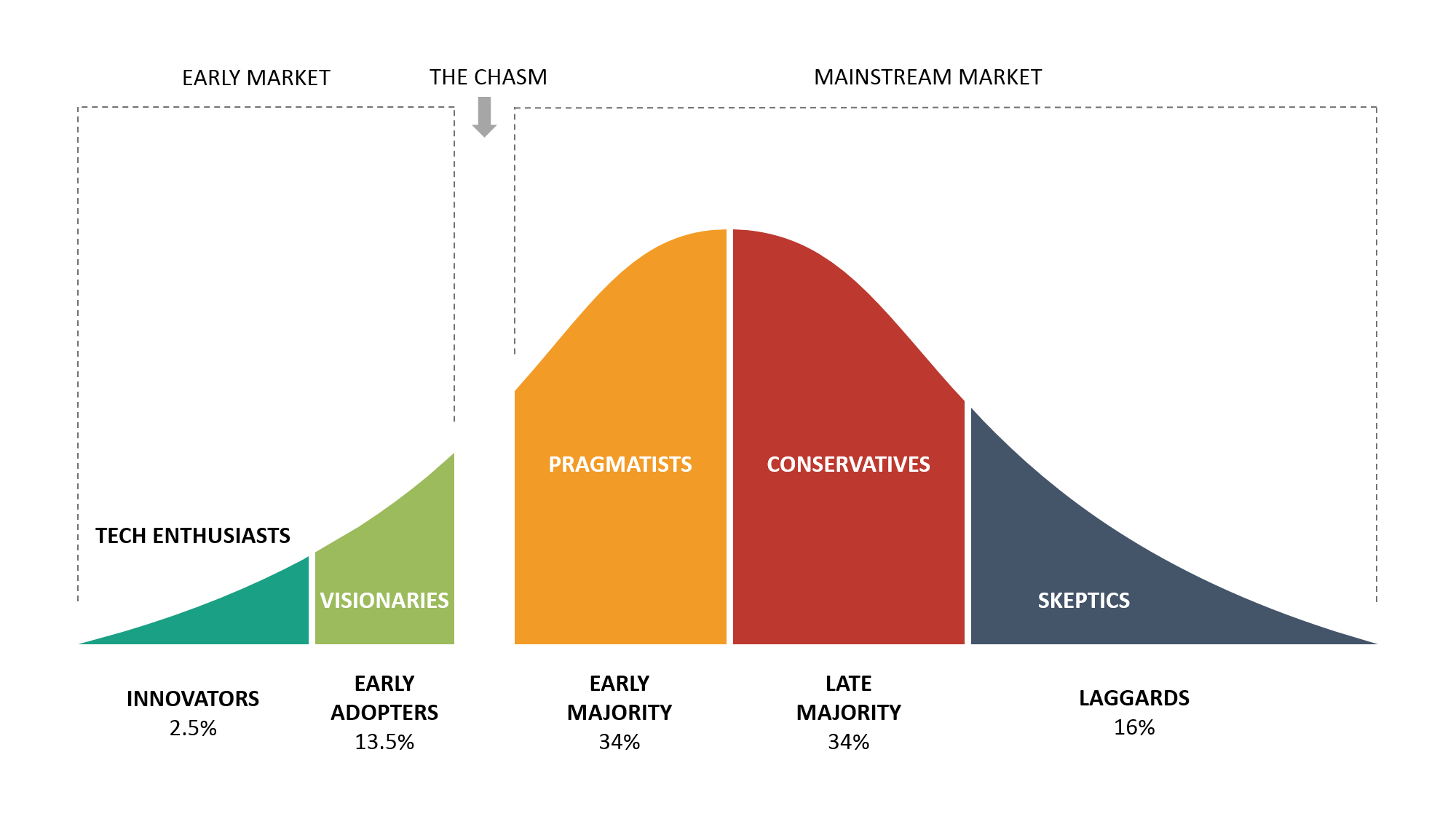How to onboard your friends to crypto

Dear Bankless Nation,
Crossing the Chasm is required reading for understanding tech adoption.
TL;DR: Bringing cutting-edge technology to the masses requires crossing a “chasm” when transitioning from early adopters to the early majority.
This is where most technologies fail.

The key to crossing the chasm varies. Sometimes the bridge is user experience, virality, pricing, or some other lever.
But in crypto the bridge is you.
Crypto is complex. It’s technical, philosophical, financial, economic, and more. Getting involved isn’t as easy as seeing something on Twitter and signing up for a demo.
The crypto-curious will look to their friends and family for guidance.
Will you be their bridge?
Will you help crypto cross the chasm?
Here’s how Ben does it. 🔥
- RSA
How I Onboard My Friends To Crypto

If there’s one thing that holds true about most crypto natives it’s this: We’re vocal about our interest. Whether it be on Twitter, Reddit, or Discord, we just can’t and won’t stop talking about market action, projects, and the transformational potential of this technology.
While I can’t speak for everyone, my passion, and that of the other on-chain citizens I’ve come to know on a personal level, has spilled out beyond just online forums and into meatspace. It’s taken over my digital and physical life. At this point, just like many others, I’m known as the “crypto guy” among my normie friends.
When the market was red hot in May, I was persistently pestered with questions along the lines of “So…like is now a good time to buy?” and “What do you think of this coin?” While flattered that my friends would call on a humble ape like myself for this advice, as we all know crypto is more than just a hyper-growth asset class.
It’s a way of life. A new decentralized, self-sovereign world that represents an exit from the old.
If we want this new world to eat the old, it’s not good enough for people to just passively invest. Given that market participants come and go, to drive sustained adoption we must find a way to clearly demonstrate crypto’s value proposition, getting newcomers to use decentralized applications and live within the cryptoeconomy.
We have to turn tourists into citizens.
This is a challenge I grapple with every day. While you may know me as a Bankless writer, DeFi analyst, and degen, I also wear a second hat as President of the crypto club at my university (shoutout @ChapmanCrypto).
While crypto is inherently a young person’s movement, many, if not most of our prospective members are not crypto natives. At best, they’re crypto-curious, interested in learning more about the technology, the markets, and the use cases.
Because of this, a large part of my job in that role is to try and onboard new users into the ecosystem.
So how does one go about turning a normie into a native?
Let’s find out.
Principles
When trying to onboard people into crypto, it’s important to keep a few key principles in mind. Like it or not, as a crypto native you play the role of a salesperson to newcomers entering the space, and you only get one chance to make a good first impression.
While we may forget it at times, crypto is poorly represented in traditional media, is incredibly complicated and intimidating at first, and it’s easy for people new to the ecosystem to be overwhelmed. Taking it a step further, a sloppy sales pitch or demonstration can leave a bad impression of the space and a potential new user more confused and skeptical than before.
Because of this, it’s important to think through what the best path to onboarding a new user would be.
Here are some of the mental models and principles I use:
1. Gauge Interest
The first thing I try to do when onboarding someone into crypto is figure out why they’re interested in the space. Whether it be for ideological reasons, to make money in the markets, to earn high yields, or to sell artwork, there are a plethora of different reasons why someone chooses to get involved in the ecosystem.
A question as simple as “Why are you interested in crypto?” or in the case of a skeptic, “What are your concerns about crypto?” can go a long way in helping figure out the right means to onboard someone. It’s tempting to pitch our favorite project, but onboarding new people requires empathy. It doesn’t make a ton of sense to show someone interested in buying an NFT how to ape into a Pool-2 yield farm.
Figuring out a newcomer’s motivations is important because it allows you to better tailor their initial experience so they can more clearly see what crypto has to offer.
2. Changing the Information Pipeline
Crypto encompasses the complex set of technology, finance, economics, psychology, philosophy, and many other disciplines. Gaining that deep understanding is a Herculean task that requires tens, if not hundreds of hours of study. The difficulty of learning about the space is further compounded by the overwhelming amount of content available for consumption, much of which may paint crypto in an unflattering light or fail to genuinely convey the core values we hold dear at Bankless.
Because of this, I always try to guide newcomers towards reliable, educational content sources. This can include crypto-native podcasts and newsletters, such as Bankless, research services, and news outlets. In doing so, I can help give them the information they need to authentically learn about the space and form well-reasoned opinions, while still enabling them the freedom to explore projects and areas of interest on their own.
📚 Editor’s Note: Try the Ultimate Guide to Going Bankless as a start. Also a16z’s Crypto Canon is a phenomenal resource for in-depth articles on getting started in crypto!
3. Skin in the Game & Hands-on Experience
It’s difficult to understand the crypto’s value proposition and see the magic of the technology without hands-on experience.
While not everyone may be ready to self-custody and instantly become a degenerate ape, it can be immensely valuable for new users to have some financial exposure and hands-on experience using Web3.
While it’s important to remind newcomers of the risks of investing in crypto assets, and to encourage them to exercise financial responsibility, having some skin in the game, no matter the size, can prove to be incredible motivation for paying further attention to and learning more about the space.
The Levels of Engagement
Now that we’ve gone through some of the important principles to keep in mind when trying to onboard a new user, we can explore some of the practical steps in doing so.
The way I like to think about this is through “levels of engagement.” In essence, these levels represent the different degrees to which someone onboarded to crypto can participate in the ecosystem based on their interest level.
Let’s explore them in further detail below.
Level 1: Buying Crypto
In line with the “skin in the game principle,” the first thing I recommend to anyone new to the ecosystem is to buy some crypto for themselves. As discussed above, holding crypto assets can serve as a powerful force in fueling curiosity to learn more about the markets and the space, potentially leading them to increase their engagement level — especially when number go up!
On a more practical note, it can also teach someone the basics of how to buy crypto (this is a question I get asked a lot), what’s the difference between Bitcoin and Ethereum, what an exchange is, and the difference between custodial and non-custodial services.
Additionally, buying and holding crypto can serve as a valuable introduction to what is perhaps crypto's most important characteristic: Its strong sense of community. At its core, the crypto ecosystem consists of a wide variety of overlapping communities. There are network communities, such as the Bitcoin and Ethereum communities, sector communities such as with DeFi and NFTs, and protocol or asset-specific communities such as the SushiSwap and CryptoPunk communities.
Buying and holding an asset can make a newcomer feel a part of the community because, like those already in it, they share the common desire of wanting to see its price increase. Everyone is in it together, like sports fans rooting for the same team.
This is a powerful, emotional force that is largely absent from all other asset classes.
Furthermore, I’ve noticed that holding through the pumps, dumps, and volatility of the crypto market with a friend can serve as a unique way to bond and generate natural, organic conversation about the space.
Level 2: Using A Dapp
Many that have been newly onboarded to crypto don’t make it past Level 1 in that they are content with just getting pure price exposure. That’s okay — venturing beyond the confines of an exchange can be complicated, intimidating, and of course, risky. This is, as we like to say on Bankless, the frontier after all.
However, there is an ever-increasing number of new users that I’ve come across willing to explore. As DeFi, NFTs, and other sectors of crypto grow, many are beginning to realize that the use cases extend far beyond that of trading and investments.
The best way to help newcomers understand the potential for these use cases, and frankly, how cool and easy to use Web3, is by having them try out dapps for themselves while guiding them through the process of doing so.
This can take many different forms depending on what the onboardees' interests are. For instance, when someone asks me how to buy an NFT I’ll walk them through how to set up MetaMask, send ETH to their wallet, and use OpenSea. For those interested in using DeFi, I’ll walk them through how to make a trade on a DEX, provide liquidity, and get a loan in a money market.
Hands-on experience using a decentralized application not only showcases the power of Web3, but also teaches one how to make transactions, how gas works, what block times are, how to setup a non-custodial wallet, and many more important functions and concepts that are a prerequisite for true on-chain citizenship.
Level 3: Ecosystem Participation
It’s one thing to own some crypto, use a DEX, or buy an NFT on a marketplace. It is another to be an active part of a community or engage in discourse.
This is the highest level of engagement when it comes to onboarding newcomers to crypto. As we’ve discussed above, crypto runs on community. Without an active community of supporters and contributors, a project, protocol, or network will die out. Because of this, I’ll always try to encourage friends that are really interested in the space and have put in the time to learn to get on crypto twitter to become part of the conversation, join the Discord of their favorite project, or even start trying to find work within the space to break into the industry.
Not only does this help a newcomer keep their finger on the pulse of the industry, but it is the strongest possible form of reinforcement to the notion that crypto is real. Witnessing a friend get a job and build a livelihood within the space serves as the strongest possible signal that the cryptoeconomy is not just a toy or a gimmick, but instead a legitimate venue in which one can build a future and life for themself.
Conclusion
It’s not easy to onboard newcomers to crypto.
The frontier is a ruthless, dangerous, intimidating place. As crypto natives striving to create a better future and more decentralized world, it’s up to us to bring in new users in a thoughtful, intentional way.
This is how I think about onboarding a new user to crypto.
How will you do it?
Action Steps
- 🗣️ Talk to your crypto-curious friends! See where their interests lie.
- 🤝 Take the time to hand-hold your friends and get them started.
- 📰 Send them the Ultimate Guide to Going Bankless or this podcast!
